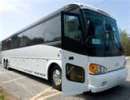
FICEMS to Consider Mexican Hat Report July 12
The Federal Interagency Committee on Emergency Medical Services has been meeting with several groups as it works to implement NTSB's recommendations following the 2008 bus crash.
Much discussed among EMS organizations for the past three years, the Mexican Hat, Utah, crash of a chartered motorcoach on Jan. 6, 2008, showed the need for a better trauma care system for rural America and also enhanced wireless service along highly traveled rural roads. Descending a steep grade, the bus hit a guardrail and rolled off the highway around 3:15 p.m. while returning some members of a large ski trip group from Telluride, Colo., to Phoenix. Nine of the 52 passengers died, and the others were injured. NTSB concluded the driver's fatigue was the cause; he had inadequate sleep during the trip and used his CPAP machine intermittently, the board found.
Since NTSB issued its recommendations in 2009, the National Highway Traffic Safety Administration's Federal Interagency Committee on Emergency Medical Services (FICEMS) has been meeting with several groups as it works to implement the recommendations directed to it: 1) develop a plan by which states and EMS agencies can pursue funding for enhanced wireless coverage that facilitates prompt emergency response on high-risk rural roads, and 2) develop guidelines for EMS response to large-scale rural transportation accidents.
The committee's next meeting, July 12 in Washington, D.C., will include continued discussion of the response to NTSB's recommendations, an update on helicopter EMS recommendations, and the presentation of the report and draft response on Mexican Hat crash recommendations, according to NHTSA's Federal Register notice.
NTSB also recommended that NHTSA issue stronger motorcoach passenger protection standards.
The remote location of the bus crash caused responders to travel long distances to and from the scene -- two ambulances traveled 230 miles from Grand Junction, Colo., and three came 117 miles from Moab, Utah. The closest hospital was 75 miles away, in Monticello, Utah, and the nearest trauma center was in Grand Junction. "Unfortunately, this accidents highlights the obvious limitation of an emergency response system that relies on air transport," NTSB said in some of its May 2009 recommendations. Weather grounded the two helicopters that were requested from Grand Junction and Phoenix, and as a result, transfers to a fixed-wing air ambulance were made in Moab after a 117-mile trip by ground ambulance.
The meeting will be held from 1 to 4 p.m. EDT at the Department of Homeland Security, Office of Health Affairs, 1120 Vermont Avenue NW. Contact Drew Dawson, director of the NHTSA Office of Emergency Medical Services, at 202-366-9966 or [email protected] for more information.